Datura, Thorn AppleJimson Weed, StramoniumDhattura (Ayurveda and Unani) Thang phrom ཐང་ཕྲོམ (Tibetan) |

|

|
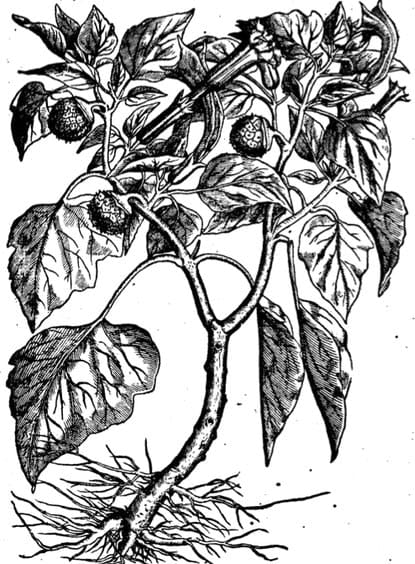 New Kreuterbuch, Matthiolus, 1563
New Kreuterbuch, Matthiolus, 1563 |
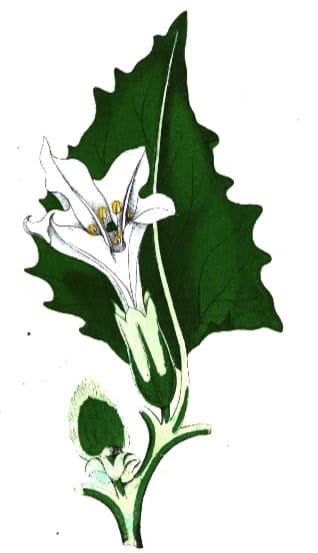 Materia Medica Botanica, Wellman, 1845
Materia Medica Botanica, Wellman, 1845 |
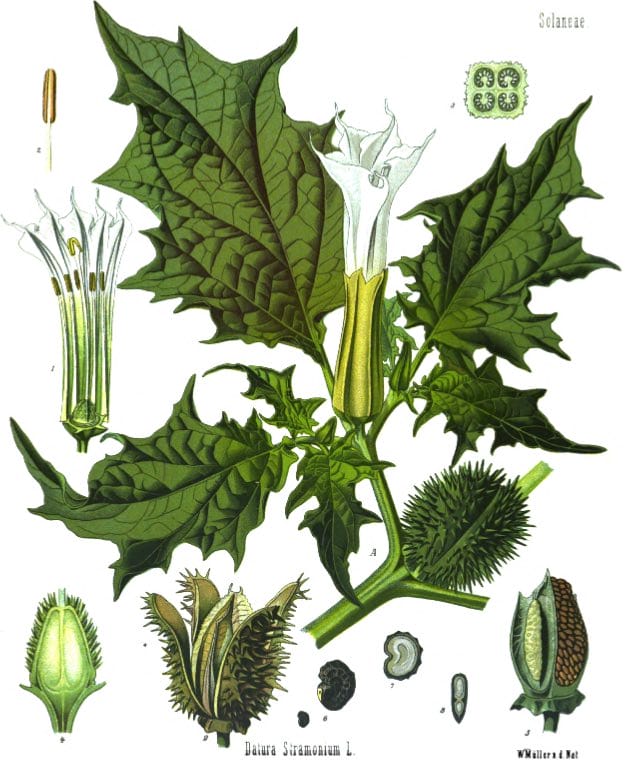 Medical Botany, Woodville, 1810
Medical Botany, Woodville, 1810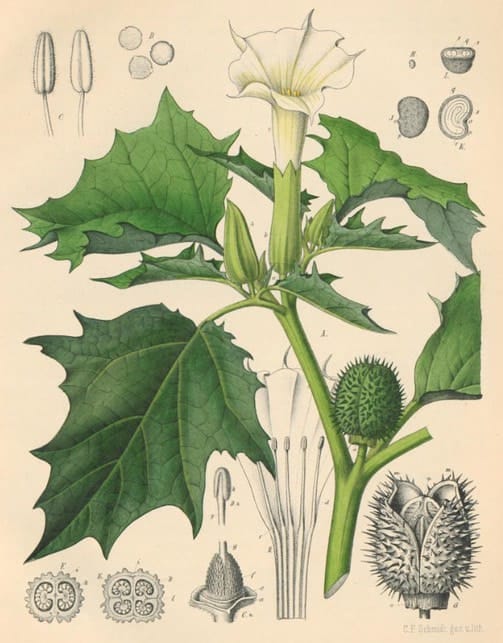 Atlas der Officinellen Pflanzen, Berg & Schmidt, Leipzig, 1893
Atlas der Officinellen Pflanzen, Berg & Schmidt, Leipzig, 1893
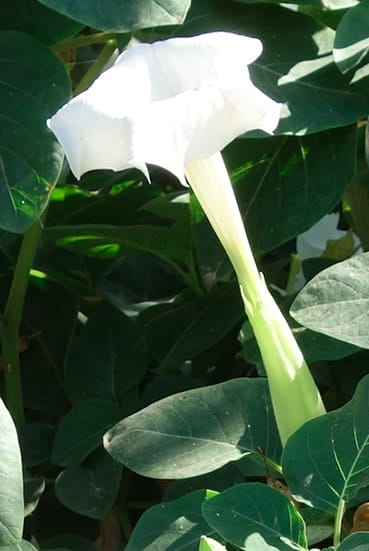
|
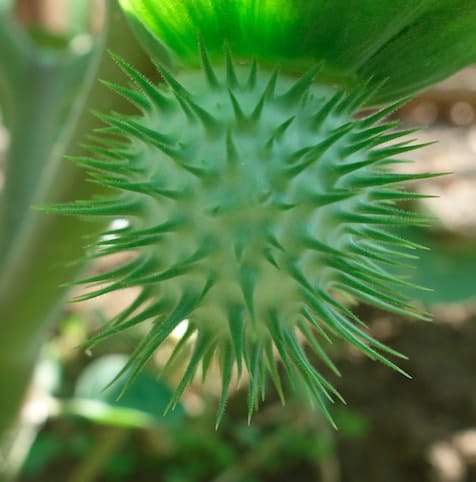
Left: Flower, Above: Seed pod (Adam, 2017) |
Botanical name:Datura stramonium Others used include D. alba, D. metal, D. Ferox, D. fastuosa Parts used:Primarily Leaf, Seed; also Root. Flowers are used in TCM Temperature & Taste:Warm, dry. Bitter, pungent, toxic. Classifications:2I. ANTISPASMODICS 2O. ASTRINGENTS Stop Cough and Wheezing Medicines for Internal Wind TCM: T. External Medicines |
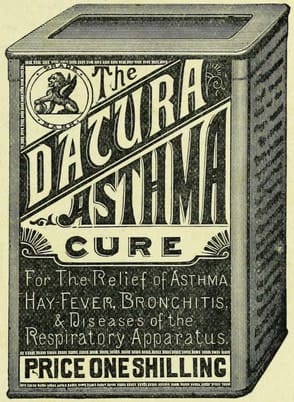 Proprietary mediicne for
Proprietary mediicne for Asthma, based on Datura. |
Uses:
1. Calms the Mind, Stops Spasm, Eases Pain:
-rheumatic pains, neuralgia
-Parkinson’s Diseases, Epilepsy, Convulsions
-Madness, acute Mania and active forms of Insanity, especially for destructive, furious or aggressive tendency
-fearlessness, restlessness, alternating fits of laughter and crying
-sexual sedative in Nymphomania; Catalepsy due to religious excitement.
-has been used to help break Opium addiction.
-has been used for Motion Sickness.
-spasmodic retention of urine and urethral stricture
2. Clears Phlegm, Calms Spasms, Stops Coughing and Wheezing:
-Spasmodic Cough, Bronchitis, Whooping Cough, Wheezing, Asthma, etc.
-Considered a better cough remedy than opium.
-Used for these purposes either internally, as herbal cigarettes, or burning powders which are inhaled; this method has been practiced in China, India, Persia and Europe.
-In TCM the flowers are decocted for these purposes
3. Resists Poison:
-various Poisons, Fevers
-Boils, Eruptions, both internally and topically.
-parched seeds are used for phlegm and bile types of Malarial fever in Ayurveda.
4. Regulates the Heart:
-Heart disorders including angina, palpitation with distress, and aortic disorders.
-Its use is similar to Atropine.
5. Benefits Complexion:
-In India, it is said to clear the Complexion.
6. Aphrodisiac:
-The seed is said to be strongly Aphrodisiac in Ayurveda.
7. Externally:
i. topically to ease pain and reduce inflammation; used for rheumatic pain of the muscles or joints, and neuralgia. (juice, poultice, oil)
ii. pain from Abscesses, Hemorrhoids etc.
iii. applied to Tumors and Cancers: The leaf is ‘a good Anodyne in Cancerous Breasts’ (Floyer, 1687, The Touchstone of Medicines).
iv. Excellent for heat conditions of the skin including Eczema, Burns and Scalds.
v. leaf decocted in oil was applied to burns and scalds.
vi. In India, Coconut Oil in which a paste of the seeds has been heated is used as a topical application for Alopecia;
vii. Seed paste decocted in Sesame oil has been applied to Psoriasis. (India)
viii. An Oil is also made by boiling equal parts of Datura juice with Sesame Oil; 3 drops are dropped into the ears for Earache.
ix. Seed powder is applied to decayed teeth to relieve Toothache; the warm or bruised fresh leaf may be applied over the painful tooth.
Dose:
1. Licorice lessens the toxicity so should be combined when used internally.
Seed: 30mg in powder; up to 50–70 seeds have been used to promote euphoria.
Dried Flower: 300–600mg in pills or powder (Chinese Pharmacopoeia, flower of D. metel)
Dried Leaf (2 grains) mixed with white sugar (4 scruples). Powder and divide into 8 doses.
It can be rolled into a cigarette and smoked for Asthma (maximum 1500mg daily)
Preparation:
1. Soak Datura seed in Cow urine for 12 hours, wash, then beat gently to remove the husk. Dry and keep. (Some sources do not mention removing the husk). (Ayurveda)
2. Datura seeds are steamed with Cow’s Milk in Dolayantra for 3 hours. Next they are washed with hot water, then dried in the Sun. (Ayurveda)
Correctives:
1. Cotton is regarded as the best corrective for Datura; leaf for leaf; seed for seed; flower for flower; root for root.
2. Black Pepper, Fennel (Unani)
3. Licorice reduces the toxicity
Substitutes:
1. Datura and Henbane are similar in both usage and dosage.
2. Datura has also been used as a suitable substitute for Belladonna.
3. It has been stated that tincture of Datura (1:8) taken in 20 drops doses is equal to 1 grain of Opium
Main Combinations:
1. Cough, Asthmatic Bronchitis, Bronchial Asthma:
i. Take the fruiting pod of Datura, split, fill with salt, smear with dung, and bake in a fire. When cool, powder and take some with sugar. (Ayurveda)
ii. Datura seed with Rhubarb, Ginger, Gum Arabic (as in Pills of Shafa of Unani)
iii. Datura flower, Ephedra Ma Huang, Bitter Almond kernel (Ku Xing Ren), Forsythia Lian Qiao (as in Zhi Chuan Ling Zhu She Ye)
iv. Dautra herb with Ginger, Long Pepper (Ayurveda)
v. Datura seed (2 parts), Black Pepper, Long Pepper, Ginger, Aconite, Sulphur (1 part each) (Ayurveda)
2. Asthma, to be burned and inhaled:
i. “Asthma.—Stramonium leaves, 20 grains ; put in a pipe and smoke it, or roll the same into cigarettes and smoke them”.
(The medical genius, Jones, 1887)
ii. Datura leaf, Yarrow, Rose, Coltsfoot
iii. Datura leaf, Belladonna (30 parts), Niter (5 parts), Opium (2 parts)
iv. Datura seed, Rhubarb, Ginger, Gum Arabic (as in Pills of Shafa of Unani)
3. Nocturnal Emission, Datura with Black Pepper and Gum Arabic (as in Pills of Datura of Unani)
4. Rheumatism, Datura seed (1 scruple), Camphor (1 dram), Savin (5 scruples), extract of Senega (4 scruples)
5. Opium addiction, Datura, Rhubarb, Ginhger, Acacia. This has been used successfully for Opiate addiction to help prevent relapse.
6. “Puerperal Convulsions.—“I never, failed yet with stramonium tincture, 20 drops; repeated in half an hour, if necessary.” (The medical genius, Jones, 1887)
7. “Puerperal Mania.—“Stramonium tincture, 10 drops, taken every 3 hours, soon restores calm and renews the flow of milk.” (The medical genius, Jones, 1887)
8. Insanity, the roots of D. alba are boiled in milk and given with Ghee and Treacle (Ayurveda)
9. As an anesthetic, Datura flower, Cannabis flower (equal parts). Powder, take 3 qian (9 grams) with wine. Shortly after, the person will ‘get drunk and tend to sleep’. (Li Shi Zhen)
10. As an application to Arthritic pain, decoct Marshmallow, Southernwood, Wormwood and Datura (2 oz. each) in 6 pints of Vinegar for 20 minutes, strain and add Saltpeter (2 drams). (Family Botanic Guide, Fox, 1924)
11. Inflammation of the Breast, Datura seed and Turmeric are made into a paste and applied (Ayurveda)
12. Lice, the leaves are boiled in oil as a topical application. (Ayurveda)
13. Psoriasis, the seeds are boiled in Sesame oil and mixed with alkaline water from the ashes of Colocasia (Taro). (Ayurveda)
Major Formulas:
Electuary of Steel (Unani)
Pills of Shafa (Unani)
Cautions:
1. Very toxic in overdose
2. Not used in Hypertension, Glaucoma, Tachycardia or Acute Pulmonary edema. Some add Prostatitis.
3. Should not be used in the very Young, Pregnant, or very Weak.
4. As it is a potent Narcotic, it is liable to cause dependency and addiction if used in full doses over a period of time.
5. Overdose has been associated with temporary, sometimes permanent blindness.
Toxicity:
Multiple organ toxicity of Datura stramonium seed extracts
Antidotes:
1. Licorice has been used to moderate and counter the effects of Datura.
The following are Antidotes used in Ayurveda:
2. Milk and Wine Vinegar have also been used.
3. Cow Urine mixed with Sugar.
4. Cotton pods and seeds may be decocted and given.
5. Water which has been mixed with Ghee or Sesame Oil.
6. A mixture of Cooked Rice, Curds, and Calamus.
7. Half a pound of Milk taken with half an ounce of Sugar.
Main Preparations used:
Extract, Tincture
|
‘The Sanskrit names Dhustura or Dhattura, and Uumatta, ”insane,” include all the species and varieties of the plant, and are the source from which the vernacular names are derived. We know of no aboriginal name for the plant, and consequently infer that it was introduced into India at the time of the Arian invasion. The Marathi name Pisola appears to be derived from the Sanskrit [?] to hurt or injure. Sanskrit writers sometimes specify whether black or white Dhustura is to be used, but do not draw any distinction between the properties of the different plants. In modern native practise the black or purple-flowered variety of D. fartuom is preferred. In the Nighantas Dhustura bears numerous synonyms, such as Dhurta, “rogue”; Kitava, ” crazy”; Matula, “maternal uncle”; Tarala, “libidinous,” &c. It is described as intoxicating, digestive, emetic and heating; useful in fever, skin diseases, boils, itch, worms, insanity, &c. Hindu physicians frequently prescribe the drug in fever attended with catarrhal symptoms, but combine it with so many other remedies that it is difficult to judge how much of the effect produced is due to the Datura. The Svalpajvarankusa may be taken as a specimen of this kind of prescription; it contains mercury, sulphur, aconite, ginger and long and black peppers, of each one part, to two parts of Datura seeds. The dose is 4 grains of the mass, which is directed to be made with the assistance of lemon juice. As a local application to inflamed and painful parts, the pounded leaves mixed with turmeric in the form of a paste are much used as a domestic remedy. Similar pastes are made with the fruit and juice, with or without opium, and mixed with oil; they are used to destroy lice and in parasitic skin diseases. A pill made of the pounded seeds is placed in decayed teeth to relieve toothache, and the leaves are smoked along with tobacco in asthma. According to Dutt, no mention of the latter use of the plant is to be found in old Hindu books. Mahometan writers also are silent upon this point. Ainslie found upon enquiry that the physicians of Southern India were unacquainted with the value of Datura in spasmodic asthma, but he tells us that his friend, Dr. Sherwood of |
Chittore, noticed the smoking of D. fastuosa as a remedy in that disease. In the Concan the juice of the same plant is given with fresh curds in intermittent fever to the extent of one tola during the intermission, and at least two hours before the fever is expected. The seeds also often enter into the composition of the bakha, used in the fermentation of country spirits, and Norman Chevers states that bakha is also frequently added to Kaita, an intoxicating drink prepared from the fruit of Feronia elephantum, and indulged in by the lower classes during the Holi festival. The several species of Datura are described by Mahometan writers under the Arabic name of Jouz-el-mathil. The Persian name is Tatulah. The author of the Makhzan recommends preference to be given to the purple kind; he says that all parts of the plant are powerfully intoxicating and narcotic; as a local application they relieve the pain of tumours, piles,&c. The roasted leaves applied to the eyes give relief in ophthalmia, similarly they are useful in headache, enlarged testicles, boils, &c. The following description of Datura intoxication is by the same author:— ‘”Every thing he (the patient) looks at appears dark; he fancies that he really sees all the absurd impressions of his brain, his senses are deranged, he talks in a wild, disconnected manner, tries to walk but is unable, cannot sit straight, insects and reptiles float before his eyes, he tries to seize them, and laughs inordinately at his failure. His eyes are bloodshot, he sees with difficulty, and catches at his clothes and the furniture and walls of the room. In short, he has the appearance of a mad man.” (Mahhzan, article “Jouz-el-mathil“) The leaves and seeds of D. fastuosa have been made official in the Pharmacopoeia of India, and of these a tincture, extract, plaster and poultice are directed to be made. The extract has been used successfully at the General Hospital, Madras, as a substitute for extract of belladonna. The value of the plant as a remedy for painful syphilitic nodes, tumours, &c, is well known to many European physicians in India. For a description of the physiological effects of Datura, the reader is referred to the article upon Belladonna. (Pharmacographia Indica, Dymock, 1891) |
